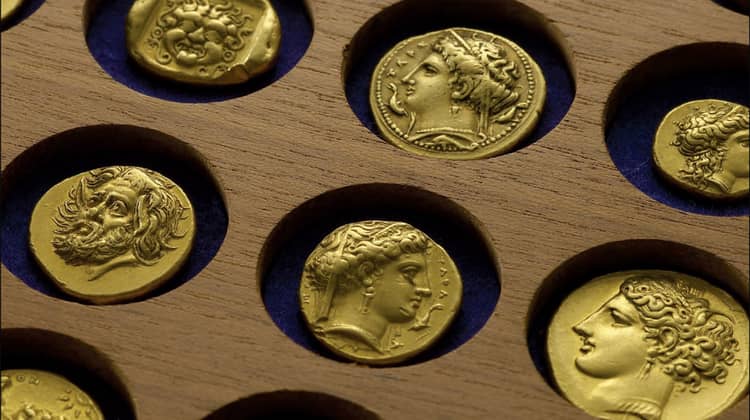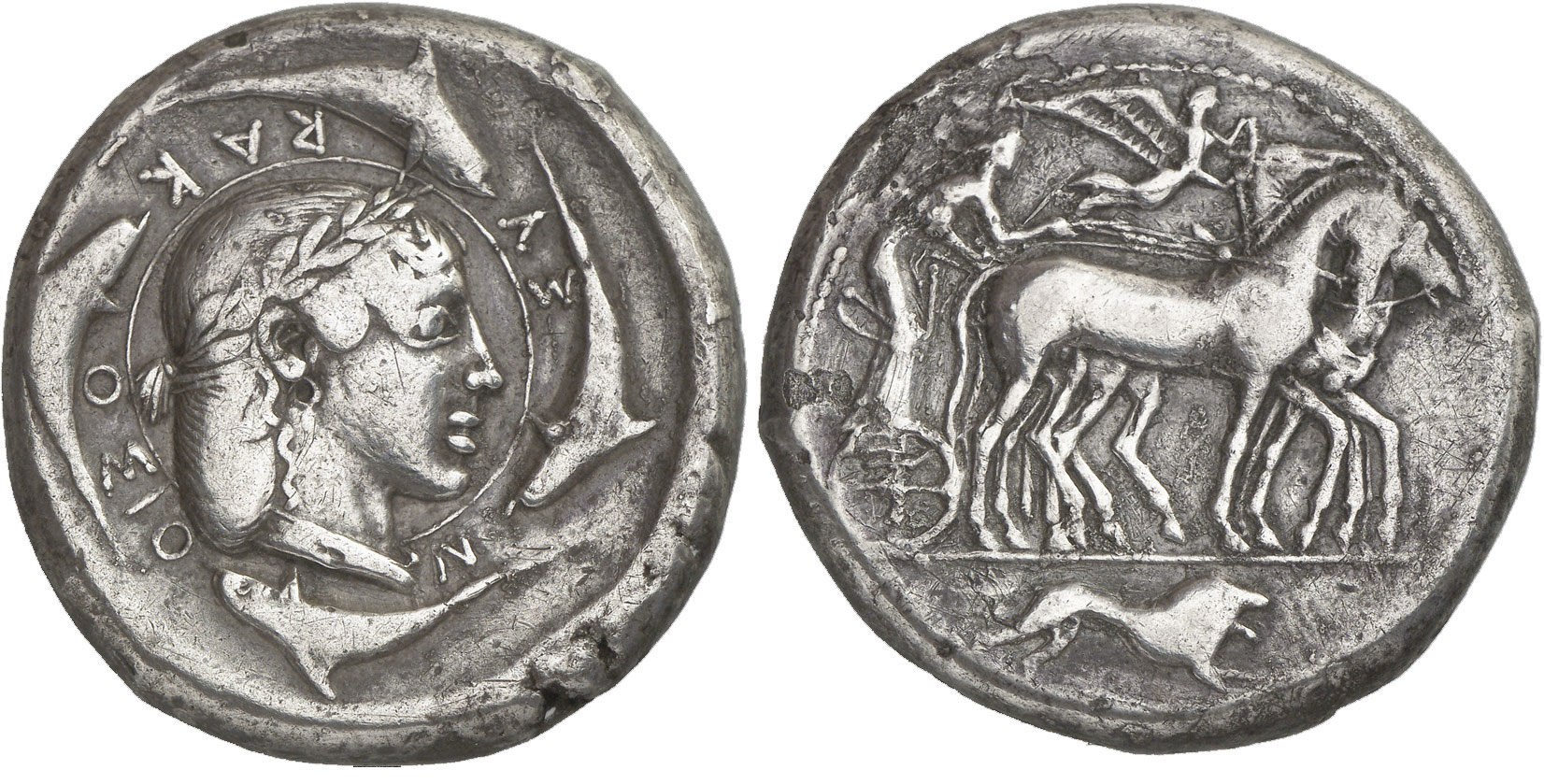
Antique gold and silver coins of Ancient Greece are a priceless source of information about the culture, history, and traditions of antique civilization. Every copy has its own image and a set of symbols that allow us to know more about the development of trade and international relations, important historical personalities, and religion. You can find all Antique gold and Silver Greece coins in our catalog.
History
Before the appearance of coins, trade in the ancient world was carried out by exchanging goods. It was not always convenient, because the seller might not have had the right product. The invention of a common monetary unit simplified this task. The first minted electrum coin (an alloy of gold and silver) appeared in Lydia, a territory bordering with Ancient Greece. Greeks quickly learned the features of minting. The first copies were created in Aegina (595-456 BC) and then in major poleis – Athens (575 BC) and Corinth (570 BC). All Greece Athens (575 BC) gold coins in our catalog.
Do you know? The largest number of coins was found in Athens during archaeological excavations – about 100,000 copies, 14,000 of them – in the Agora (the market of ancient Athens). The money was minted from bronze and had the smallest denomination.
The first ancient Greek coins were made of silver. Each of them had the same weight. Every coin depicted a turtle – a symbol of the prosperity of the city and sea trade. Images were supplemented with a brand, which was a guarantee of full weight and good quality of money.
Do you know?
Aegina coin with the image of a turtle, according to scientists, was the first widely recognized currency, intended not only for local use. There were about 10,000 turtles minted during 70 years on the island (due to such amount of copies many of them were perfectly preserved to our days). The most valuable ones are those issued when Aegina was occupied by Athens and lost its sea domination. They depict a land tortoise (there was a sea turtle on early ones).
Later, when the coins started to be minted in every major polis, the problem arose. The weight was not the same. The trade relations on international level became a problem again. To improve trade relations, the allied poleis agreed to issue coins of the same weight. The money of some settlements was in particular demand. That brought an impressive income to the treasury. The most popular in the whole history were the Athenian tetradrachms, the Rhodian stater, the ancient Greek gold coins the staters of Kizik.
Over time, a system of weights for minting was developed in Ancient Greece:
- Miletus (VII-VI centuries BC) – stater14 g of electrum, popular on the coast of Asia Minor (all Miletus Greece gold coins in our catalog)
- Phocaean (VI-IV centuries BC) – stater 16 g of electrum, was minted in Kizik, Italy;
- Persian (VI-IV centuries BC) – gold daric (8.4 g.) and silver shekels (5.6 g)
- Aegian (VII-VI centuries BC) – stater of 12.4 g of silver, distributed in the Cycladic islands, in Northern and Central Greece, the Peloponnese, Delphi, and Olympia, in the Northern Black Sea region.
Also, there was the Eubenean, Corinthian, Phoenician and Rhodian system, but the Attic standard of minting became the only one.
Do you know? Silver or gold coins were rarely used in everyday transactions or sales. Most likely, they were transferred to the state in the form of taxes or fees. The kings paid the military with money from precious metals. Thus, silver and gold coins are often found in good condition, unlike bronze or copper coins, which were used for daily trade.
The counting system after the Solon’s reform:
- talent (60 minas) = 26.196 g;
- mina (100 drachms) = 436.6 g;
- drachma (6 obolos) = 4.366 g;
- obol = 0.728 g;
- chalcus = 0.091 g (in silver).
Mina and talent are countable units (there was no such denomination).
Due to the outstanding commander Alexander the Great and his legendary conquests, ancient Greek gold coins spread throughout the Mediterranean coast, Asia Minor and the Black Sea region. Even after the king’s death, his portrait was minted on the obverse in different images (during 200 years). Ancient Greek money came out of use, along with the expansion of Rome and the emergence of the Eastern Roman Empire.

Design
Initially, coins of Ancient Greece were made of silver, electrum, and gold. Later they were made from bronze and copper. The metal was melted in the forge; then it was poured into vessel molds and cut into flans (empty coins), from which billets of the same size and weight were made. Engravers worked on creating a stamp with symbols. First, the master cut out simple reliefs, signs, and symbols only on one side. Eventually, they learned to create pictures on the reverse and obverse (the edge was absent).
Do you know?
Counterfeiting of coins in the ancient world was not uncommon, especially in Athens. If one of the residents suspected that the money was not real, they brought it to a market or port to check. If the coins were considered fake, they were marked with a deep cut and consecrated to the mother of the gods.
Each age is distinguished by the features of minting:
Silver coins in Ancient Greece could be easily distinguished by symbols. Athenian money depicted Athena and her owl, the Minotaur maze was on the Knossos’, Syracusian money was distinguished by the image of Arethusa with dolphins. The celery leaf is depicted on the monetary unit of Selinus, the rose was present on the coins of Rhodes and the wheat was on the money of Metapont. Most often images of the gods Apollo in the laurel wreath, Athens, Ares, Artemis, Aphrodite were used. Also, you could find animals – a lion, a bull, horses, dolphins, a dove and a griffin.

Do you know?
The process of minting involved a team of three people. The first brought a red-hot flange from the furnace, the second held the stamp in place, and the third took a hammer and beat on the billet. He also took out the finished coin from the mold to replace it with a new flan. This process made it possible to make one monetary unit of precious metal in 3 seconds. To mint money faster, they set up a few anvils in mints, which made it possible to make up to 1,000 coins a day.
Gold coins of Ancient Greece appeared during the reign of Alexander the Great. Many of them were made so exquisitely that they were recognized as a work of art in the world of numismatics. The engravers diligently worked to show the portrait resemblance, the psychology of a person and realistic actions (not always in a positive way). One of them – a stater from Pantikapaeum with a profile of Satire – was sold for 3.8 million.
Cost
The most popular Hellenistic Ancient Greek silver coins:
The price of gold Ancient Greek coins starts from 5,000 $ and goes up to 3,800,000 $ (the price depends on a purity of gold, place and year of minting).
Comments
No commens yet.